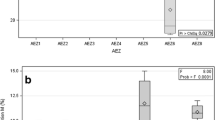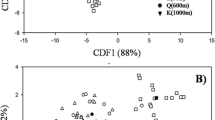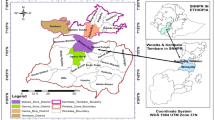Abstract
Purpose
Arbuscular mycorrhizal (AM) fungi represent a functionally important component of soil microbial communities. It is critical to achieve an improved understanding of the community structure of the indigenous AM fungi if we are to use this group of fungi either as indicators of ecosystem health or to enhance the sustainability of agricultural systems. In the present study, we assessed the impact of land use and soil depth on the number and community composition of infective AM fungal propagules in high-input agricultural ecosystems.
Materials and methods
Three different agricultural land use systems with high management intensity were selected, i.e., vegetable greenhouses, arable land, and open vegetable fields. Soil samples were collected from different soil depths (0–30, 30–60, and 60–90 cm) of three replicated (triplicate) land-use types at two sites in north China. The modified mean infection percentage (MIP) method was used to determine the inoculum potential of each soil sample. The community composition of AM fungi was analyzed using PCR, cloning, and sequencing techniques.
Results and discussion
Land use and soil depth greatly influenced the development of root-associated AM fungi and also edaphic properties. MIPs and species richness were lower in the top (0–30 cm) of soil profile in the vegetable greenhouses than in the nearby open vegetable fields or arable fields. Moreover, AM fungal distribution in the soil profile varied with land use. The MIPs and species richness decreased with increasing soil depth in the arable land and open vegetable fields. By contrast, in the greenhouse vegetable soils, the highest richness was found in the deepest soil depth (60–90 cm). The presence and prevalence of AM fungi also varied with land-use type and soil depth. Of the 13 total phylotypes investigated, Glo 6, Div 1, and Glo 1 accounted for 82.8 % of AM fungal clones analyzed and were present in each land-use type and soil depth. There were some observed phylotypes that were only found below 30 cm depth (Glo 4, Glo 5, Div 3, and Div 4).
Conclusions
AM fungal infectivity and richness were not always lower in the deeper soil profiles in the greenhouse than in the agricultural fields. High land-use intensity was correlated with a preferential persist of some AM fungi in the deeper soil layers to escape from the adverse conditions caused by intensive farming practices.




Similar content being viewed by others
References
Abbott LK, Robson AD (1991) Factors influencing the occurrence of vesicular–arbuscular mycorrhizas. Agric Ecosyst Environ 35:121–150
Anderson EL, Millner PD, Kunishi HM (1987) Maize root length density and mycorrhizal infection as influenced by tillage and soil phosphorus. J Plant Nutr 10:1349–1356
Augé RM (2001) Water relations, drought and vesicular–arbuscular mycorrhizal symbiosis. Mycorrhiza 11:3–42
Borowicz VA (2001) Do arbuscular mycorrhizal fungi alter plant–pathogen relations? Ecology 82:3057–3068
Brady NC, Weil RR (1996) Organisms and ecology of the soil. The nature and properties of soil, 11th edn. Prentice-Hall, Upper Saddle River, pp 328–360
Cambardella CA, Gajda AM, Doran JW, Wienhold BJ, Kettler TA (2001) Estimation of particulate and total organic matter by weight loss on ignition. In: Lal R, Kimble JM, Follett RF, Stewart BA (eds) Assessment methods for soil carbon. Lewis, Boca Raton
Chagnon PL, Bradley RL, Maherali H, and Klironomos JN (2013) A trait-based framework to understand life history of mycorrhizal fungi. Trends Plant Sci 18:484–491
China Ministry of Agriculture, 2008. China Agriculture Statistical Data. China Agriculture Press, Beijing, China,p. 16 (in Chinese)
Clapp JP, Young JPW, Merryweather J, Fitter AH (1995) Diversity of fungal symbionts in arbuscular mycorrhizas from a natural communitiy. New Phytol 130:259–265
Daniell TJ, Husband R, Fitter AH, Young JPW (2001) Molecular diversity of arbuscular mycorrhizal fungi colonising arable crops. FEMS Microbiol Ecol 36:203–209
Development Core Team R (2011) R: A language and environment for statistical computing. R Foundation for Statistical Computing, Vienna
Douds DD, Johnson NC (2004) Contributions of arbuscular mycorrhizas to soil biological fertility. In: Abbott LK, Murphy DV (eds) Soilbiological fertility: a key to sustainable land use in agriculture. Springer, Berlin, pp 129–162
Douds DD, Millner P (1999) Biodiversity of arbuscular mycorrhizal fungi in agroecosystems. Agric Ecosyst Environ 74:77–93
Douds DD, Janke RR, Peters SE (1993) VAM fungus spore populations and colonization of roots of maize and soybean under conventional and low-input sustainable agriculture. Agric Ecosyst Environ 43:325–335
Entry JA, Rygiewicz PT, Watrud LS, Donnelly PK (2002) Influence of adverse soil conditions on the formation and function of arbuscular mycorrhizas. Adv Environ Res 7:123–138
Franke-Snyder M, Douds DD, Galvez L, Phillips JG, Wagoner P, Drinkwater L, Morton JB (2001) Diversity of communities of arbuscular mycorrhizal (AM) fungi present in conventional versus low-input agricultural sites in eastern Pennsylvania, USA. Appl Soil Ecol 16:35–48
García JP, Wortmann CS, Mamo M, Drijber RA, Quincke JA, Tarkalson D (2007) One-time tillage of no-till: effects on nutrients, mycorrhizae, and phosphorus uptake. J Agron 99:1093–1103
Good IJ (1953) The population frequencies of species and the estimation of population parameters. Biometrika 40:237–264
He FF, Chen Q, Jiang RF, Chen XP, Zhang FS (2007) Yield and nitrogen balance of greenhouse (Lycopersicum esculentum Mill) with conventional and site-specific nitrogen management in Northern China. Nutr Cycl Agroecosyst 77:1–14
Helgason T, Daniell T, Husband R, Fitter AH, Young J (1998) Ploughing up the wood-wide web? Nature 394:431
Hijri I, Sykorová Z, Oehl F, Ineichen K, Mäder P, Wiemken A, Redecker D (2006) Communities of arbuscular mycorrhizal fungi in arable soils are not necessarily low in diversity. Mol Ecol 15:2277–2289
Jakobsen I, Nielsen NE (1983) Vesicular-arbuscular mycorrhiza in field-grown crops. I. Mycorrhizal infection in cereals and peas at various times and soil depths. New Phytol 93:401–413
Jakobsen I, Rosendahl L (1990) Carbon flow into soil and external hyphae from roots of mycorrhizal cucumber plants. New Phytol 115:77–83
Jansa J et al (2002) Diversity and structure of AMF communities as affected by tillage in a temperate soil. Mycorrhiza 12:225–234
Jansa J, Mozafar A, Kuhn G, Anken T, Ruh R, Sanders IR, Frossard E (2003) Soil tillage affects the community structures of mycorrhizal fungi in maize roots. Ecol Appl 13:1164–1176
Jansa J, Wiemken A, Frossard E (2006) The effects of agricultural practices on arbuscular mycorrhizal fungi. In: Frossard E, Blum W, Warkentin B (eds) Function of soils for human societies and the environment. Special Publication of the Geological Society 266:89–115
Jiao H, Chen YL, Lin XG, Liu RJ (2011) Diversity of arbuscular mycorrhizal fungi in greenhouse soils continuously planted to watermelon in North China. Mycorrhiza 21:681–688
Johnson NC (1993) Can fertilizatioin of soil select less mutualistic mycorrhizae? Ecol Appl 3:749–757
Johnson D, Vandenkoornhuyse PJ, Leake JR, Gilbert L, Booth RE, Grime PJ, Young JPW, Read D (2003) Plant communities affect arbuscular mycorrhizal fungal diversity and community composition in grassland microcosms. New Phytol 161:503–515
Ju XT, Kou CL, Christie P, Dou ZX, Zhang FS (2007) Changes in the soil environment from excessive application of fertilizers and manures to two contrasting intensive cropping systems on the North China Plain. Environ Pollut 145:497–506
Kabir Z, O’Halloran IP, Widden P, Hamel C (1998) Vertical distribution of arbuscular mycorrhizal fungi under corn (Zea mays L) in no-till and conventional tillage systems. Mycorrhiza 8:53–55
Kiers ET, West SA, Denison RF (2002) Mediating mutualisms: farm management practices and evolutionary changes in symbiont co-operation. J Appl Ecol 39:745–754
Köhl L, Oehl F, van der Heijden MGA (2014) Agricultural practices indirectly influence plant productivity and ecosystem services through effects on soil biota. Ecol Appl 24:1842–1853
Krüger M, Stockinger H, Krüger C, Schüßler A (2009) DNA-based species level detection of Glomeromycota: one PCR primer set for all arbuscular mycorrhizal fungi. New Phytol 183:212–223
Kurle JE, Pfleger FL (1994) Arbuscular mycorrhizal fungus spore populations respond to conversions between low-input and conventional management practices in a corn–soybean rotation. J Agric 86:467–475
Lauber CL, Strickland MS, Bradford MA, Fierer N (2008) The influence of soil properties on the structure of bacterial and fungal communities across land use types. Soil Biol Biochem 40:2407–2415
Lekberg Y, Koide R, Twomlow S (2008) Effect of agricultural management practices on arbuscular mycorrhizal fungal abundance in low-input cropping systems of southern Africa: a case study from Zimbabwe. Biol Fert Soils 44:917–923
Li MG (2000) Operating principles and techniques of plant genes. Tianjin Science and Technology Press, Tianjin
Li XL, George E, Marschner H (1991a) Phosphorus depletion and pH decrease at the root-soil and hyphae–soil interfaces of VA-mycorrhizal white clover fertilized with ammonium. New Phytol 119:397–404
Li XL, Marschner H, George E (1991b) Acquisition of phosphorus and copper by VA-mycorrhizal hyphae and root to shoot transport in white clover. Plant Soil 136:49–57
Li XL, Gai JP, Cai XB, Li XL, Christie P, Zhang FS, Zhang JL (2014) Molecular diversity of arbuscular mycorrhizal fungi associated with two co-occurring perennial plant species on a Tibetan altitudinal gradient. Mycorrhiza 24(2):95–107
Liu RJ, Li M, Wang FY (2001) A preliminary research on the species diversity of arbuscular mycorrhizal fungi in the greenhouse vegetable lands. J Laiyang Agric Coll 18:280–283 (in Chinese)
Maherali H, Klironomos JN (2012) Phylogenetic and trait-based assembly of arbuscular mycorrhizal fungal communities. PLoS ONE 7:36695
Martinez TN, Johnson NC (2010) Agricultural management influences propagule densities and functioning of arbuscular mycorrhizas in low- and high-input agroecosystems in arid environments. Appl Soil Ecol 46:300–306
Meharg AA, Cairney JWG (2000) Co-evolution of mycorrhizal symbionts and their hosts to metal-contaminated environments. Adv Ecol Res 30:69–112
Moorman T, Reeves FB (1979) The role of endomycorrhizae in revegetation practices in the semi-arid west. Part II. A bioassay to determine the effect of land disturbance on endomycorrhizal populations. Am J Bot 66:14–18
Murty D, Kirschbaum MUF, McMurtrie RE, McGilvray A (2002) Does conversion of forest to agricultural land change soil carbon and nitrogen? A review of the literature. Glob Change Biol 8:105–123
Neville J, Tessier JL, Morrison I, Scarratt J, Canning B, Klironomos JN (2002) Soil depth distribution of ecto- and arbuscular mycorrhizal fungi associated with Populus tremuloides within a 3-year-old boreal forest clear-cut. Appl Soil Ecol 19:209–216
Newman EI, Reddell P (1987) The distribution of mycorrhizas among families of vascular plants. New Phytol 106:745–751
Oehl F, Sieverding E, Ineichen K, Mader P, Boller T, Wiemken A (2003) Impact of land use intensity on the species diversity of arbuscular mycorrhizal fungi in agroecosystems of central Europe. Appl Environ Microbiol 69:2816–2824
Oehl F, Sieverding E, Mader P, Dubois D, Ineichen K, Boller T, Wiemken A (2004) Impact of long-term conventional and organic farming on the diversity of arbuscular mycorrhizal fungi. Oecologia 138:547–583
Oehl F, Sieverding E, Ineichen K, Ris EA, Boller T, Wiemken A (2005) Community structure of arbuscular mycorrhizal fungi at different soil depths in extensively and intensively managed agroecosystems. New Phytol 165:273–283
Oehl F, Laczko E, Bogenrieder A, Stahr K, Bösch R, van der Heijden M, Sieverding E (2010) Soil type and land use intensity determine the composition of arbuscular mycorrhizal fungal communities. Soil Biol Biochem 42:724–738
Olsen SR, Sommers LE (1982) Phosphorus. In: Page AL, Miller RH, Keeney DR (eds) Methods of soil analysis, part 2. Am Soc Agron and Soil Sci Soc Am, Madison
Post WM, Mann LK (1990) Changes in soil organic carbon and nitrogen as a result of cultivation. In: Bowman AF (ed) Soil and the greenhouse effect. Wiley, New York, pp 401–407
Pozo MJ, Azcón-Aguilar C (2007) Unraveling mycorrhiza-induced resistance. Curr Opin Plant Biol 10:393–398
Qiu SJ, Ju XT, Ingwersen J, Qin ZC, Li L, Streck T, Christie P, Zhang FS (2010) Changes in soil carbon and nitrogen pools after shifting from conventional cereal to greenhouse vegetable production. Soil Tillage Res 107:80–87
Redecker D (2002) Molecular identification and phylogeny of arbuscular mycorrhizal fungi. Plant Soil 244:67–73
Redecker D, Hijri I, Wiemken A (2003) Molecular identification of arbuscular mycorrhizal fungi in roots: perspectives and problems. Folia Geobot 38:113–124
Richter BS, Tiller RL, Stutz JC (2002) Assessment of arbuscular mycorrhizal fungal propagules and colonization from abandoned agricultural fields and semi-arid grasslands in riparian floodplains. Appl Soil Ecol 20:227–238
Sanders IR (2004) Plant and arbuscular mycorrhizal fungal diversity—are we looking at the relevant levels of diversity and are we using the right techniques? New Phytol 164:415–418
Schloss PD, Handelsman J (2005) Introducing DOTUR, a computer program for defining operational taxonomic units and estimating species richness. Appl Environ Microbiol 71:1501–1506
Simon L, Bousquet J, Lévesque RC, Lalonde M (1993) Origin and diversification of endomycorrhizal fungi and coincidence with vascular land plants. Nature 363:67–69
Smith SE, Read DJ (2008) Mycorrhizal symbiosis, 3rd edn. Academic, New York, London, p 787
Tawaraya K, Saito M, Morioka M, Waqatsuma T (1994) Effect of phosphate application to arbuscular mycorrhizal onion on the development and succinate dehydrogenase activity of internal hyphae. Soil Sci Plant Nutr 40:667–673
Vandenkoornhuyse P, Husband R, Daniell TJ, Watson IJ, Duck JM, Fitter AH, Young JPW (2002) Arbuscular mycorrhizal community composition associated with two plant species in a grassland ecosystem. Mol Ecol 11:1555–1564
Verbruggen E, Roling WFM, Gamper HA, Kowalchuk GA, Verhoef HA, vander Heijden MGA (2010) Positive effects of organic farming on below-ground mutualists: large-scale comparison of mycorrhizal fungal communities in agricultural soils. New Phytol 186:968–979
Zhu JH, Li XL, Christie P, Li JL (2005) Environmental implications of low nitrogen use efficiency in excessively fertilized hot pepper (Capsicum frutescens L.) cropping systems. Agric Ecosyst Environ 111:70–80
Acknowledgments
We thank the National Basic Research Program of China (Project 2009CB119000), the innovative group grant of NSFC (No. 31121062), and the National Natural Science Foundation of China (Projects 41071179 and 41271269) for financial support.
Author information
Authors and Affiliations
Corresponding author
Additional information
Responsible editor: Ian Anderson
Rights and permissions
About this article
Cite this article
Gai, J., Gao, W., Liu, L. et al. Infectivity and community composition of arbuscular mycorrhizal fungi from different soil depths in intensively managed agricultural ecosystems. J Soils Sediments 15, 1200–1211 (2015). https://doi.org/10.1007/s11368-015-1060-3
Received:
Accepted:
Published:
Issue Date:
DOI: https://doi.org/10.1007/s11368-015-1060-3




